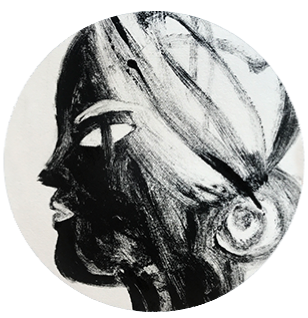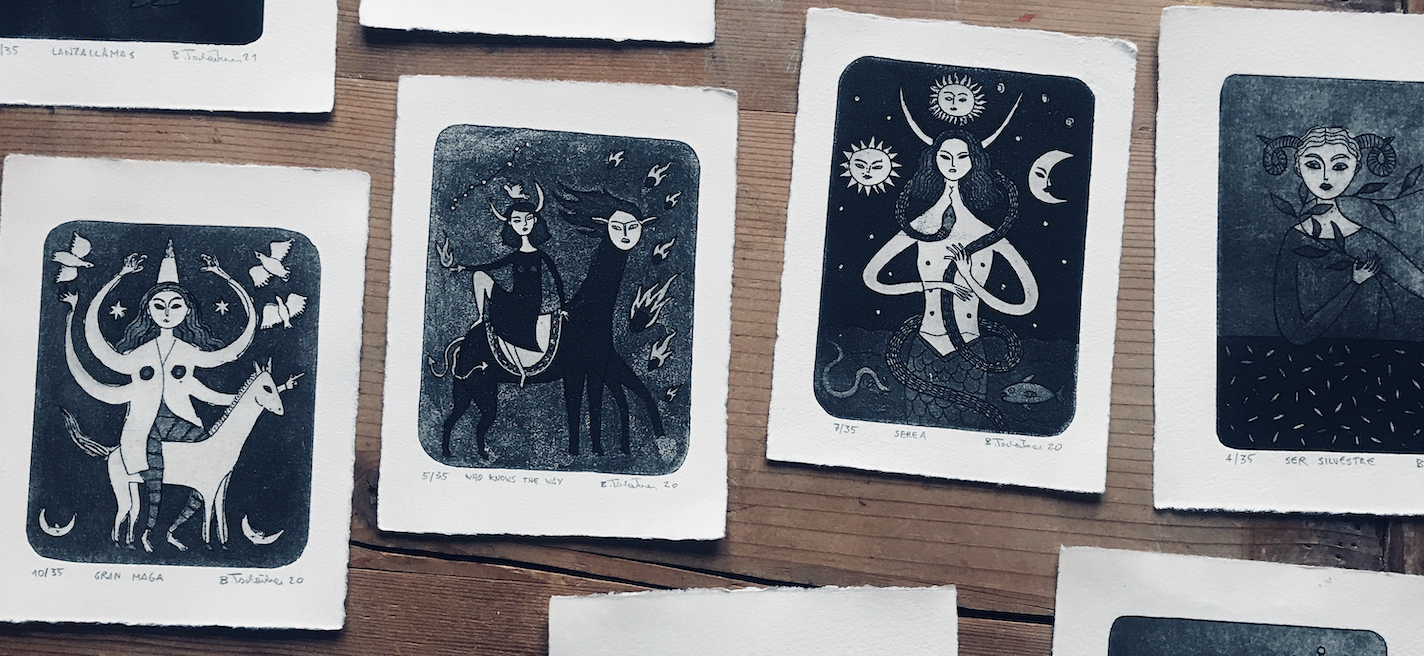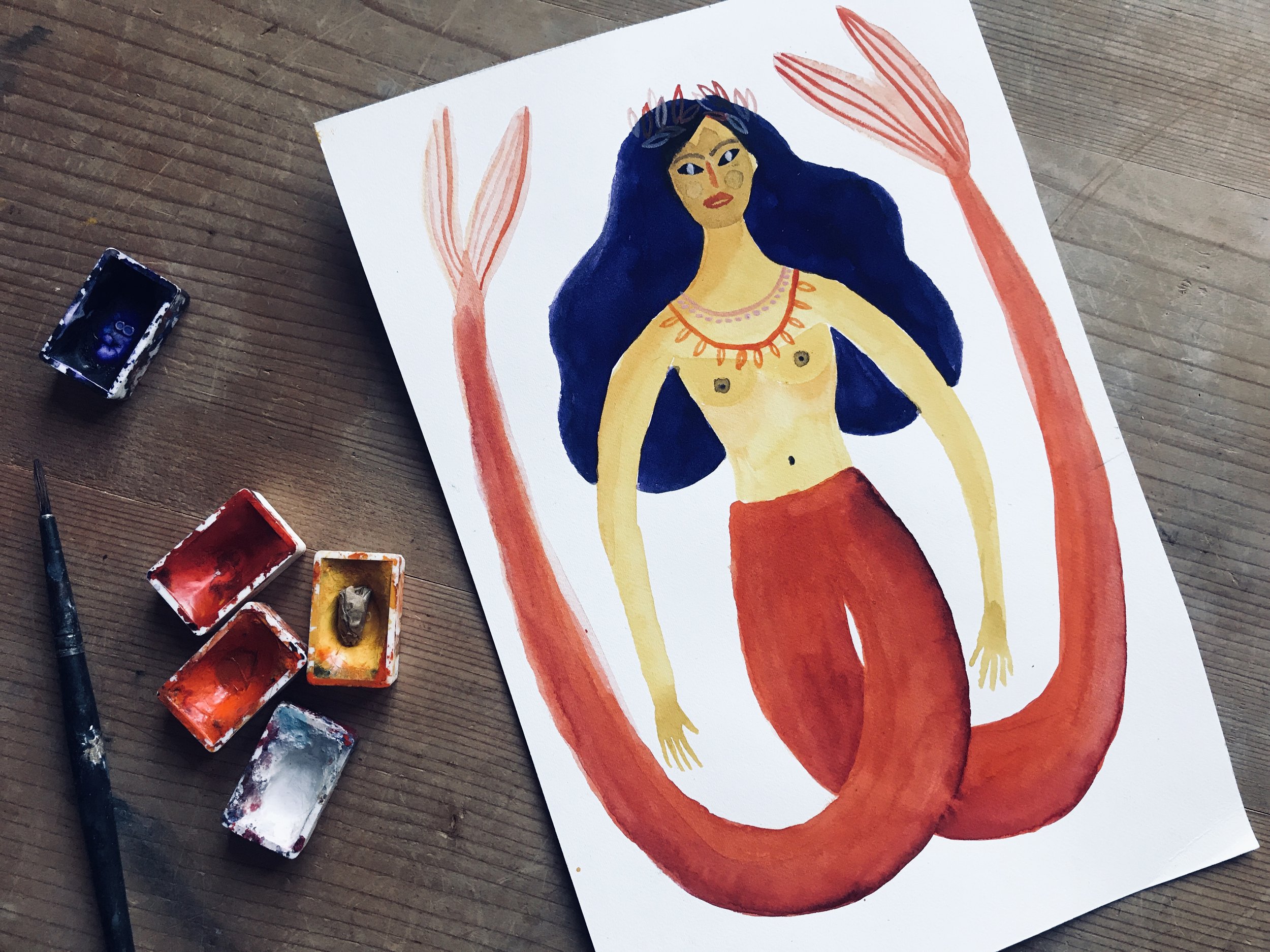Last year I created several artworks inspired by Melusina, the two-tailed mermaid, a figure that really fascinates me – the Melusina is an old matriarchal symbol uniting the erotic and the motherly aspect of the female nature, two aspects we have been gaslighted by patriarchy to perceive as a contradiction but which, of course, always have been two sides of one and the same coin.
These are two of my favorite works, an aluminum sculpture I created after a papercut and a lithography. These two were ordered together by an art collector from Vienna. In the last years, a few collectors have mentioned to me that they feel that certain artworks they purchased from me protect and guard their homes, and I have to admit that my artwork being perceived that way makes me happy – because sometimes, some of my figures also remind me of old guardian spirits.
It is, of course, not difficult to tell where they come from. What has influenced my work the most are my journeys, and what I discovered on them: From ancient temples on the Arabian peninsula where weather and time has washed away the faces and limbs of deities to the archaic smiles of greek goddesses after being kissed by Buddha, to the endless strips of Italian Frescoes repeating the stories of their holy book over and over, Islamic miniature painters veiling the faces of their saints with flames, and mythological creatures in the patterns of carpets, to deities so old that their names have been forgotten by everyone and new ones had to be invented, and most importantly, the thousands and thousands of deities living in India.
For most of the time in human history, art and religion have been closely intertwined. Religion always has needed art, but art doesn’t need religion and has turned away from it, for the best reasons. But as enlightened as we might be, or think we are, there is and always will be a great need of the human soul to surround itself with magic.
In the West though, we no longer feel the need for deities, and much less to lend a face to them: Our gods have started to fade away. Sometimes we go into a church and in the dim light of a candle we see a blackened altarpiece that depicts the gods and goddesses of yesterday. They look half-asleep, turned away from us, as if they were behind veils. They have become museal. It is clear that they are not amongst us anymore.
In other places in the world, the gods are still alive. Just go South, perhaps to some Mediterranean islands, and in every corner you find shrines where a candle burns day and night, burning for the Virgin Mary, who once was Venus, who once was Aphrodite, who once was Al-Uzza, who once was Inanna.
Big bright gods are ruling now great parts of the world, each of them ruling in a totalitarian manner that leaves no space for any other god, much less a goddess, but the dark corners he (it’s always a he) spares, because he doesn’t like darkness and he doesn’t like corners, are the place where small deities live.
In the East, you find all sorts of creatures protecting spaces humans have created for themselves – rooms, households, temples, streets. They live on the margins of our lives in their niches and tiny houses, almost like the small animals sharing the spaces of us humans, and I must admit that it has happened to me that I mistook a god’s house for a birdhouse. Everything and anything can be a god, because god, of course, can be everything and anything: A bird, a stone, a sexual organ even.
Unlike the big god, this old monopolist, who’s grown so tall he has become out of control, a caricature almost, these small deities co-exist in some kind of spiritual democracy with humans, and with other deities. They‘re not aloof creatures who sit clouds and judge, but they live amongst us, and their tasks are humble and important. They are our spiritual housemates: If you feed them, they teach you that what you nourish nourishes you. They provide company, blessing, protection, mutual care, characteristics in which they, again, resemble certain pets. Others are mirrors of aspects of ourselves or of aspects the world we like to be reminded of, some even are a way for people who have died to continue to exist in some way.
There are many reasons for a god to exist.
But most importantly, they are representatives of the other, or however you might call it, they lend a human face to that which is faceless and make it something you can face, something you can address: They are a way to communicate with to something that is too big to be communicated with. You can talk to them, and they stand and listen, and I think this is their most important aspect:
They are an embodiment of a sentiment human beings need to survive: That on this earth, we are, essentially, in a safe place. Through them, our deepest inside can communicate with the farthest outside.
You don’t need to be religious, and not even spiritual, to have a god. The moment you see a thing as more than a thing, the moment you attach a sentiment or a meaning beyond its mere function to it, you have created a god.
I’ve seen many goddesses and gods on my journeys through the East, and some even in the West. I’ve seen their faces, which sometimes looked as astonished as mine, sometimes their features were washed away, some where alive and some were dead, and sometimes it was a stone that was worshipped, a stone onto which someone had painted an eye.
I’ve met deities in lively churches and dormant temples, in street corners and in museums and in books, and sometimes in the houses of people. I’ve been a guest in houses of gods I’ve never heard of, local deities that only exist in a city, or even only in a single household. I’ve met many strange deities, while others, like the face of Botticelli‘s Venus, always has been as familiar to me as the face of my mother. And somewhere, deep inside of me, I’ve stored all these glances, these faces, these personalities of this enormous family of beings that exist, and don’t exist. They all sleep inside of me now, and sometimes when I make an artwork, they become alive and real again, and I recognize their faces in what I just drew, or sculpted, or painted.
And other people recognize them too. Maybe not as what they were when I saw them, or as what I intended them, or thought that I intended them to be, but as whatever they are meant to be now, and god knows what that is. And if they are meant that they bring a spirit of protection to some household, if they’re picking up that old, honorable godly duty of guarding over something, I’m content with it.







